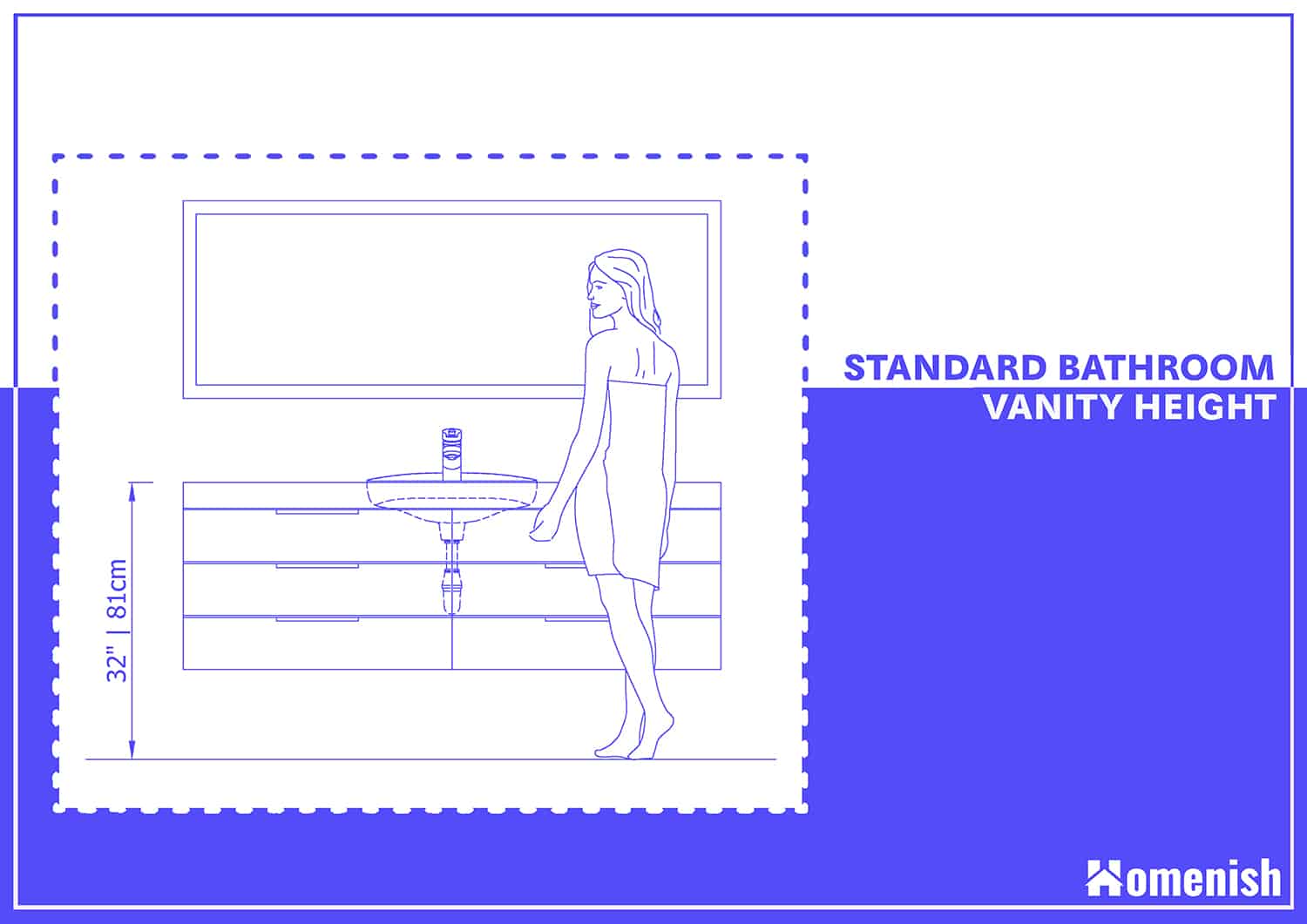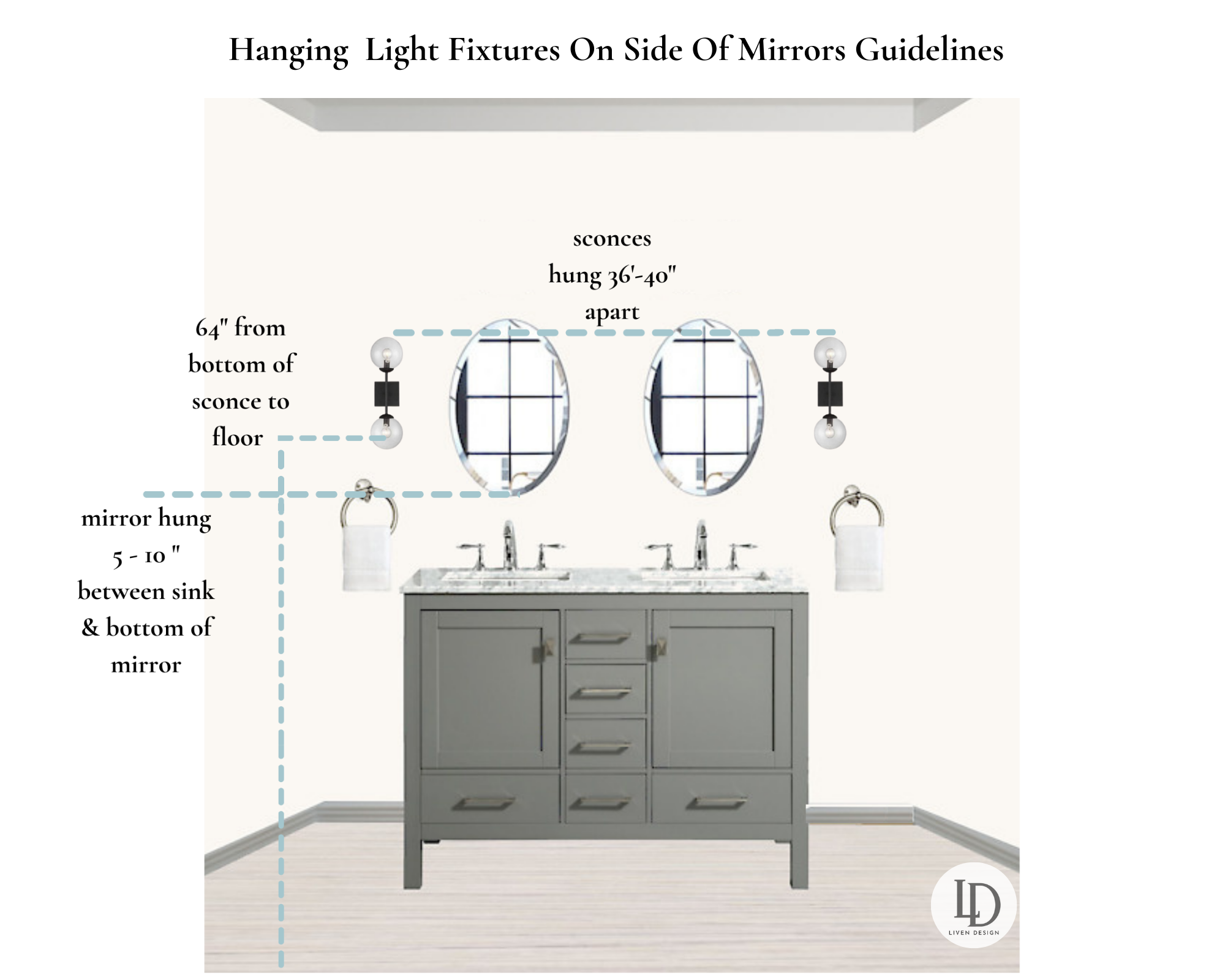Understanding Bathroom Vanity Sconce Placement

Properly placing bathroom vanity sconces is crucial for creating a functional and aesthetically pleasing space. Not only do sconces provide much-needed illumination for grooming tasks, but they also add a touch of elegance and sophistication to your bathroom decor. The height of your sconces plays a significant role in achieving both optimal lighting and visual harmony.
Sconce Height and Vanity Style
The ideal sconce height depends on the style and dimensions of your vanity. For instance, a traditional vanity with a large, ornate mirror might benefit from sconces placed higher on the wall, creating a balanced and symmetrical look. On the other hand, a contemporary vanity with a smaller, minimalist mirror might call for lower sconces, emphasizing the sleek lines of the design.
Determining Ideal Sconce Height, Bathroom vanity sconce height
To determine the ideal sconce height, consider the following factors:
- Mirror Size: The height of your mirror is a key factor in sconce placement. Ideally, the sconces should be positioned at a height that allows for even illumination of the mirror’s surface, ensuring that no shadows are cast on your face.
- Vanity Height: The height of your vanity also plays a role in sconce placement. Generally, sconces should be placed at a height that is comfortable for the user, allowing them to see their reflection clearly without having to strain their neck.
- Ceiling Height: The height of your ceiling will also influence the ideal sconce height. In rooms with high ceilings, sconces can be placed higher on the wall to create a sense of balance. Conversely, in rooms with lower ceilings, sconces should be placed lower to avoid overwhelming the space.
Choosing the Right Sconce Type
The type of sconce you choose can also impact its placement. Consider the following options:
- Wall-Mounted Sconces: These are the most common type of sconce and are ideal for traditional and contemporary vanities. They are typically mounted directly to the wall, making them a versatile option for various bathroom styles.
- Swing Arm Sconces: Swing arm sconces offer greater flexibility, allowing you to adjust the light source to suit your needs. They are a good choice for vanities with smaller mirrors, as they can be positioned to provide focused illumination.
- Pendant Sconces: Pendant sconces are suspended from the ceiling and are a popular choice for modern bathrooms. They add a touch of drama and can be used to create a focal point in the space.
Standard Sconce Heights and Considerations: Bathroom Vanity Sconce Height

Choosing the right height for your bathroom vanity sconces is crucial for both functionality and aesthetics. A well-placed sconce will provide adequate lighting for your vanity area while enhancing the overall look of your bathroom.
Bathroom vanity sconce height – The ideal sconce height for your bathroom vanity is influenced by several factors, including personal preference, the design of your vanity, and the size of your bathroom. While there are general recommendations, finding the perfect height might require some experimentation to achieve the best results.
Sconce Height Recommendations
Generally, bathroom vanity sconces are recommended to be placed between 60 and 70 inches from the floor. This height ensures that the light illuminates the vanity area effectively without being too high or too low. However, this is just a starting point, and you may need to adjust the height based on your specific needs and preferences.
- Vanity Height: Consider the height of your vanity. If you have a tall vanity, you may need to place the sconces higher to ensure they are positioned above eye level. On the other hand, if you have a shorter vanity, you might want to lower the sconces slightly.
- Mirror Size: The size of your bathroom mirror also plays a role in determining the optimal sconce height. If you have a large mirror, placing the sconces higher will help to illuminate the entire surface. For smaller mirrors, you can position the sconces lower to create a more intimate and focused lighting effect.
- Ceiling Height: The height of your bathroom ceiling can influence the placement of your sconces. In bathrooms with high ceilings, you may want to place the sconces higher to create a more balanced look. For bathrooms with lower ceilings, keeping the sconces closer to the floor can help to prevent the light from feeling too harsh or overwhelming.
Advantages and Disadvantages of Different Sconce Heights
Choosing the right sconce height can significantly impact the functionality and aesthetics of your bathroom lighting. Let’s explore the pros and cons of different sconce height options:
| Sconce Height | Advantages | Disadvantages |
|---|---|---|
| High Sconces (above 70 inches) |
|
|
| Medium Sconces (60-70 inches) |
|
|
| Low Sconces (below 60 inches) |
|
|
Adjusting Sconce Height for Different Bathroom Layouts
The placement of your bathroom vanity sconces can be adjusted to suit various bathroom layouts and achieve optimal lighting effects. Here are some practical guidelines:
- Small Bathrooms: In smaller bathrooms, consider placing the sconces lower to create a more intimate and cozy feel. Avoid placing sconces too high, as this can make the bathroom feel cramped.
- Large Bathrooms: For larger bathrooms, you have more flexibility with sconce height. You can opt for higher sconces to maximize illumination and create a more dramatic effect.
- Narrow Bathrooms: In narrow bathrooms, consider placing the sconces closer to the sides of the vanity to maximize the use of wall space and avoid obstructing movement.
- Open Concept Bathrooms: For bathrooms with an open concept design, ensure the sconce height complements the overall aesthetic and lighting scheme of the surrounding spaces.
Sconce Height Installation and Tips

Installing bathroom vanity sconces at the right height can significantly enhance the functionality and aesthetics of your bathroom. This section will guide you through the process, offering tips for ensuring proper wiring and electrical safety, choosing the right tools and materials, and troubleshooting common installation issues.
Installation Steps
Installing bathroom vanity sconces involves a series of steps that ensure proper placement, secure mounting, and safe electrical connections.
- Determine the Sconce Height: Measure the height of your vanity and determine the desired sconce placement. As a general rule, the bottom of the sconce should be approximately 60-66 inches from the floor, ensuring adequate light and a visually appealing arrangement.
- Locate the Electrical Box: Identify the location of the electrical box that will power the sconce. It should be situated within a reasonable distance from the desired sconce placement.
- Mark the Sconce Location: Using a level, mark the wall where the sconce will be mounted. Ensure the mark is at the determined height and is level with the surrounding area.
- Mount the Sconce Base: Depending on the sconce’s mounting type, you may need to use screws or adhesive to attach the base plate to the wall. Follow the manufacturer’s instructions for the specific sconce model.
- Connect the Wiring: Carefully connect the sconce’s wires to the electrical box wires. Match the black wire to the black wire, white wire to the white wire, and ground wire to the green or bare copper wire. Ensure all connections are secure and properly insulated.
- Secure the Sconce: Attach the sconce to the base plate, ensuring it is securely mounted. Test the sconce to ensure it is functioning correctly.
- Install the Bulbs: Insert the appropriate bulbs into the sconce, making sure they are compatible with the sconce’s wattage rating.
Electrical Safety Tips
Ensuring electrical safety during sconce installation is paramount. Here are some key considerations:
- Turn off the Power: Before working on any electrical wiring, always turn off the power at the circuit breaker. This prevents accidental electrocution and ensures a safe working environment.
- Use Appropriate Tools: Utilize tools specifically designed for electrical work, such as wire strippers, wire connectors, and a non-conductive ladder. Avoid using tools that could damage wires or create a safety hazard.
- Inspect Wiring: Carefully inspect all wires for damage or fraying before connecting them. Replace any damaged wires with new ones to prevent electrical faults.
- Grounding: Ensure the sconce is properly grounded to prevent electrical shocks. Connect the ground wire to the green or bare copper wire in the electrical box.
- Double-Check Connections: After connecting the wires, double-check that all connections are secure and properly insulated. Loose connections can lead to electrical problems and safety hazards.
Tools and Materials
Having the right tools and materials at hand will make the sconce installation process smoother and more efficient.
- Level: A level is essential for ensuring the sconce is mounted straight and level.
- Screwdriver: A screwdriver is needed to attach the sconce base to the wall and secure the sconce to the base plate.
- Wire Strippers: Wire strippers are used to remove the insulation from the wire ends, allowing for proper connections.
- Wire Connectors: Wire connectors are used to securely connect the sconce’s wires to the electrical box wires.
- Electrical Tape: Electrical tape is used to insulate the wire connections, preventing short circuits and electrical hazards.
- Sconce Mounting Hardware: This includes screws, anchors, or adhesive depending on the sconce’s mounting type.
- Safety Glasses: Safety glasses protect your eyes from debris and flying particles during installation.
- Non-Conductive Ladder: A non-conductive ladder provides a safe platform for reaching the sconce installation height.
Troubleshooting Common Issues
Even with careful planning and execution, you may encounter some challenges during sconce installation.
- Sconce Not Working: If the sconce doesn’t turn on, check the power supply, ensuring the circuit breaker is on and the sconce is properly wired. Inspect the connections for loose or damaged wires.
- Sconce Flickering: Flickering can indicate a loose connection, a faulty bulb, or a problem with the electrical wiring. Check the connections, replace the bulb, and inspect the wiring for any issues.
- Sconce Not Level: If the sconce is not level, loosen the mounting screws and adjust the sconce until it is level. Use a level to ensure the sconce is straight.
